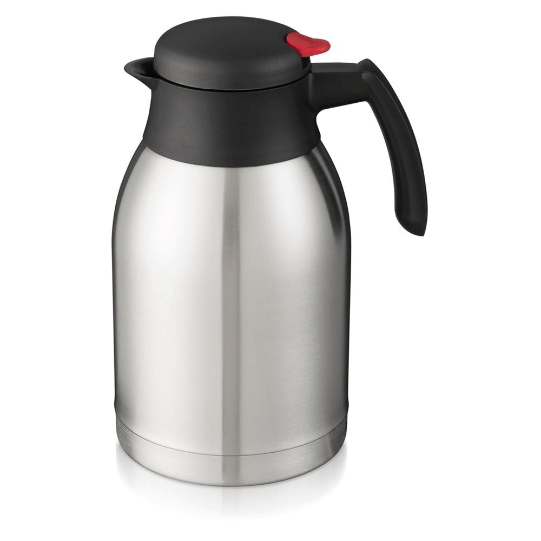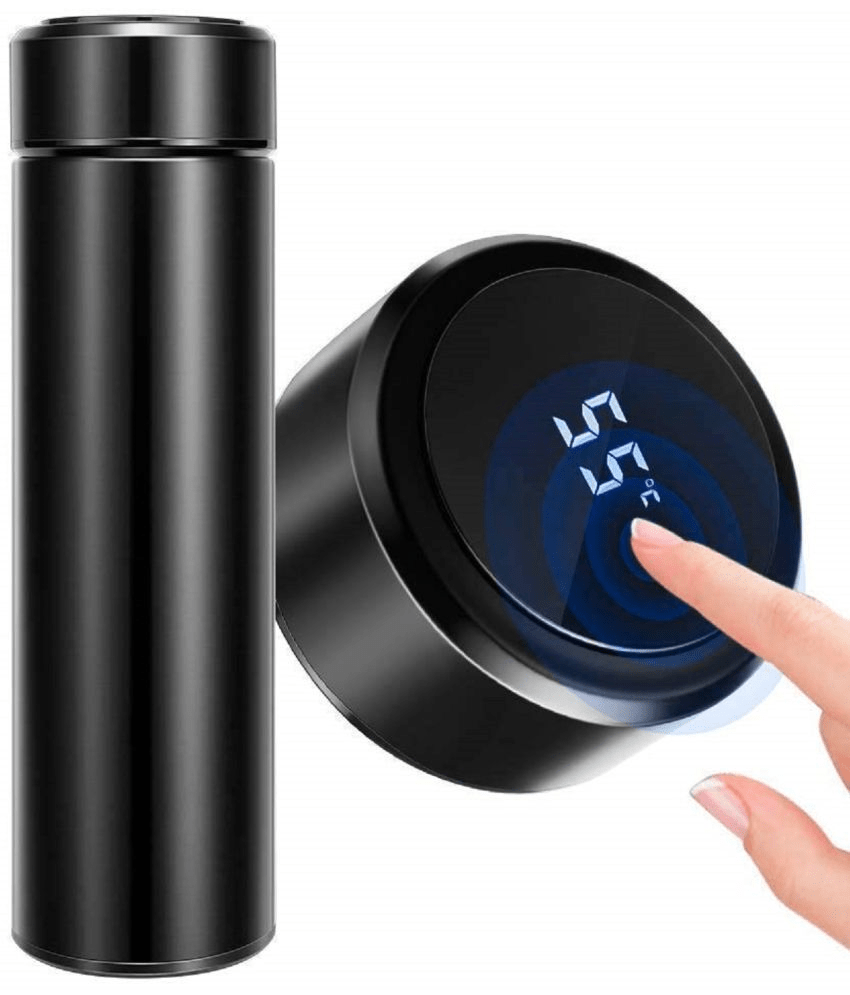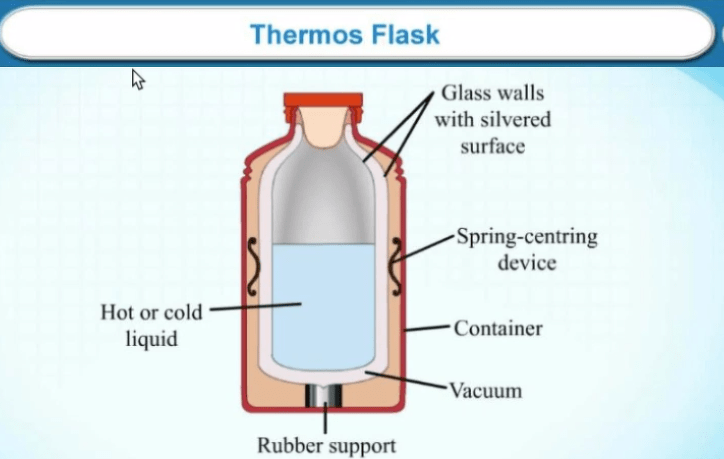What is Thermos flask?
A vacuum flask sometimes referred to as a Dewar flask, Dewar bottle, or Thermos is an insulating storage container that considerably extends the amount of time that the contents of the flask remain hotter or colder than the surroundings. Sir James Dewar created the vacuum flask in 1892, which consists of two flasks joined at the neck and nested inside one another. Since there is essentially no air in the space between the two flasks, there is little to no heat transfer through conduction or convection. This eliminates condensation on the outside of the flask when used to hold cold beverages.

Domestically, vacuum flasks are used to keep cooked meals warm and beverages hot or cold for lengthy periods of time. Thermal cooking is another use for them. In industry, vacuum flasks are used for a variety of tasks.
History of Thermos flask
As a result of his research on the topic of cryogenics, Scottish scientist Sir James Dewar invented the vacuum flask, known as a Dewar flask in his name, in 1892. Dewar built a brass chamber and surrounded it with another chamber to maintain the temperature of the palladium while conducting experiments to find the element's specific heat. To set the temperature of the contents, he partially vacuumed the space between the two chambers. Dewar declined to file for a patent on his creation.

As a result, the flask - as improved upon by others utilizing cutting-edge materials like glass and aluminum - became an important instrument for conducting chemical research as well as a staple household item. Reinhold Burger and Albert Aschenbrenner, two German glassblowers, quickly put Dewar's invention into wide usage in 1904 after understanding that it could be used to keep hot drinks hot and cold drinks cold. They also developed a flask shape that was more robust and appropriate for regular usage. Although the German men who found the Dewar flask's commercial applicability gave it the name Thermos and later claimed ownership of both the commercial product and the brand trademark, the Dewar flask design was never granted a patent.
Dewar later lost a legal battle against the firm in an attempt to assert his ownership of the idea. Thermos bottle performance and production were greatly enhanced and refined by the Viennese inventor and businessman Gustav Robert Paalen, who created a variety of models for domestic use, patented them, and widely distributed them through the Thermos Bottle Companies in the US, Canada, and the UK, which acquired licenses for their respective national markets.
The American Thermos Bottle Company established a large-scale manufacturing facility in Norwich, Connecticut, which lowered costs and allowed for the widespread distribution of the product for use at home. The corporation gradually increased the size, shapes, and materials of these consumer goods, which were largely used to transport hot or cold drinks on camping vacations and to carry coffee on the move. Eventually, other producers created comparable goods for consumer usage. Such a vacuum-insulated container for liquids subsequently came to be known by the term "thermos," which later became a generic trademark
The commercial "Thermos" was developed into a common item, and the vacuum flask continued to be utilized for numerous types of scientific operations. Although Thermos is still a registered trademark in certain countries, a court in the United States ordered it to be genericized in 1963 because it had come to be thought of as a general term for vacuum flasks. There are other vacuum flasks, though. Design A flask is made up of two containers that are linked at the neck and one inside the other. Air is partially removed from the space between the two vessels, generating a partial vacuum that lessens heat transfer or convection.

Silvering the flask sides towards the gap can reduce heat transfer by thermal radiation, but this can become troublesome if the flask's contents or surroundings are extremely hot; Vacuum flasks typically store contents below the boiling point of water because of this.
Since there is no vacuum inside the flask, the majority of heat transfer takes place through the neck and opening. In addition to being composed of metal, borosilicate glass, foam, or plastic, vacuum flasks frequently contain an opening stopper made of cork or polyethylene plastic.
Frequently utilized as insulated transport containers are vacuum flasks. Spacers are placed between the interior and outside shell of vacuum flasks that are so huge or long that the inner flask occasionally needs additional support. These spacers serve as a thermal bridge and lessen the flask's insulation to some extent when they come into touch with the interior surface. Double vacuum flasks are used in many technological applications, including MRI and NMR devices. There are two vacuum portions on these flasks. One vacuum section separates the liquid helium and liquid nitrogen in the inner and outer flasks, respectively. This limits the loss of priceless helium. The radiation shield and neck of the vacuum flask have also been improved, and both of these feature’s aid in lessening evaporation from the flask.
Research and industry for flash freezing, sample preparation, and other activities requiring the generation or maintenance of an extremely low temperature, liquid nitrogen, which has a boiling point of 77 K, is routinely stored in vacuum flasks in laboratories and industries. Larger vacuum flasks are used to store substances like oxygen and nitrogen, which turn gaseous at well below room temperature. In these cases, heat loss into the freezing interior of the bottle causes the liquid to slowly boil off, necessitating either a narrow-unstoppered opening or a stoppered opening with a pressure relief valve to prevent pressure from building up and ultimately shattering the flask.
The vacuum flask's insulation causes a very gradual "boil," which keeps the contents liquid for a long time without the use of refrigeration machinery. Traditionally, the large Zener diodes, standard cells, and printed circuit board of precision voltage-regulating devices used as electrical standards were enclosed in vacuum flasks. The flask was used to keep temperature-related changes in the output voltage of the Zener standard to a few parts per million or less. It also helped maintain the Zener temperature over a long period of time.
One significant application was in Guideline Instruments' Transvolt; type 9154B saturated standard cell; an electrical voltage saturated cell was held in place using a big glass vacuum plug in a silvered vacuum flask that was enclosed in foam insulation. The device produced 1.018 volts with an accuracy of a few parts per million. As a result, NASA made considerable use of vacuum flasks in the Saturn launch vehicles' propellant tanks during the 1960s and 1970s. They can be used to store some types of rocket fuel. The form and shape of the Dewar flask were used as a model for optical experiments because it is believed that the shape of the two compartments with the space in between is similar to how light strikes the eye. The Canadian company's standard is produced
The foundation of a device used to passively insulate medicinal shipments is an industrial Dewar flask. The majority of vaccinations are heat-sensitive and need a cold chain system to maintain constant subfreezing temperatures. To keep vaccinations at or below 10 °C, the Arktek system uses eight one-liter ice blocks. Dewar flasks are used in the oil and gas sector to isolate the electrical parts of wireline logging instruments. By placing all delicate electronic components in a Dewar flask, standard logging instruments (rated to 350°F) are converted to high-temperature standards. safety Implosion hazards exist for vacuum flasks, and unexpected shattering of glass is a particular risk for vacuum-suspended vessels.
When the vessel's temperature changes quickly, chips, scratches, or cracks may be the first sign of a dangerous vessel collapse (when hot or cold liquid is added). It is advised that the Dewar vacuum flask be properly prepared by tempering before use in order to preserve and enhance its performance. Glass vacuum flasks are frequently fitted onto a metal base with the cylinder inside, coated with mesh, aluminium, or plastic to protect the cylinder from physical damage, or are fitted into a metal base to make handling easier.